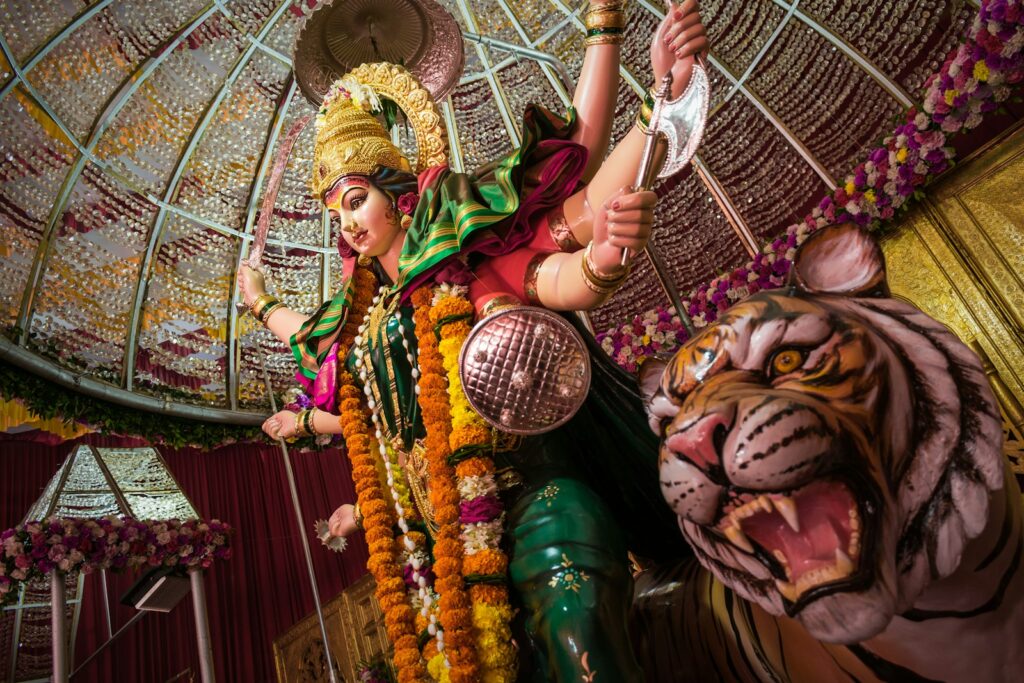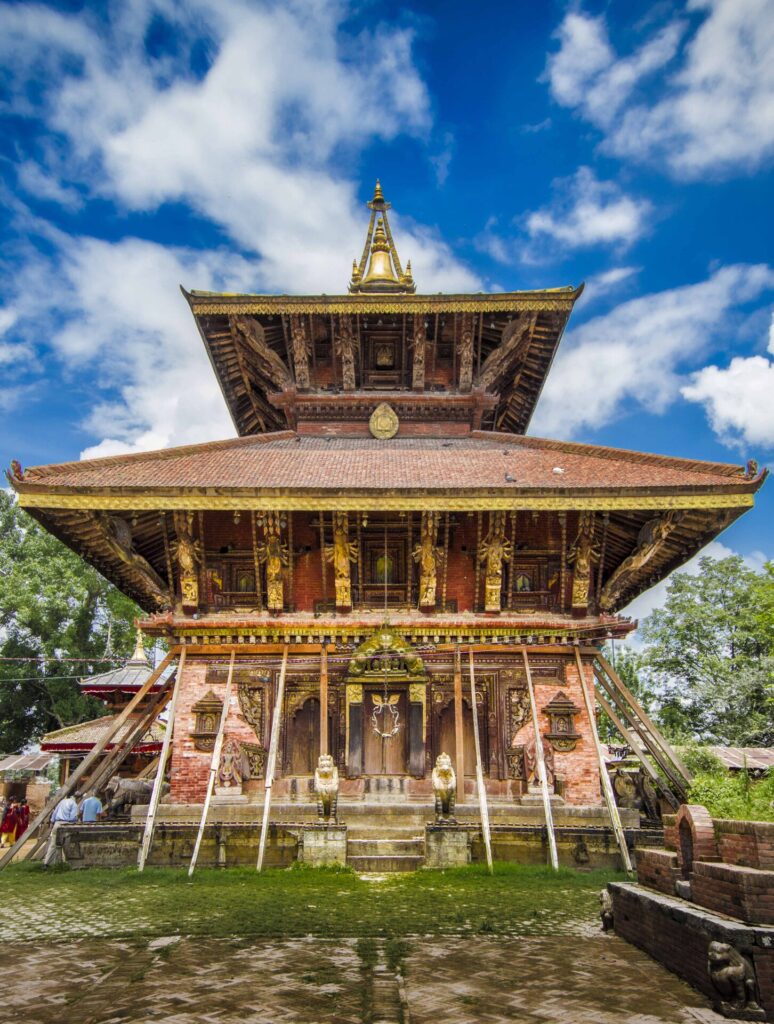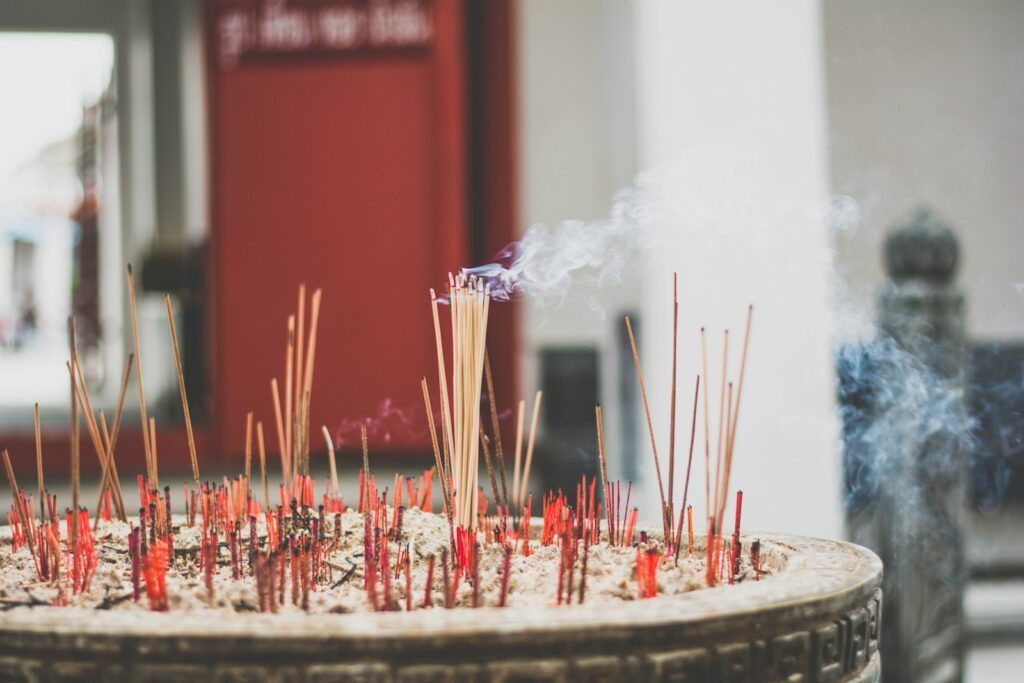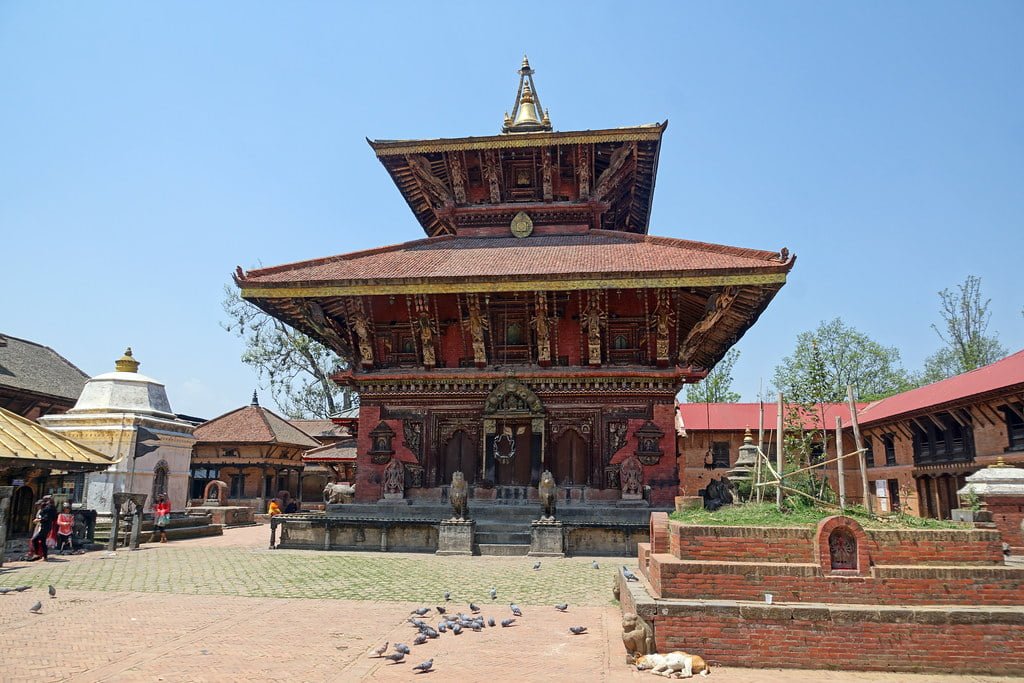Changunarayan Temple
The Changu Narayan Temple holds a rich history that dates back to the 4th century. It is believed to have been built by the Licchavi King Mandev and dedicated to Lord Vishnu. This ancient Hindu temple is considered to be one of the oldest in Nepal and is of great historical and cultural significance.
The temple is renowned for its exquisite Newari architecture, with intricate carvings and wood sculptures that are considered to be some of the finest examples of their kind. temple complex also houses statues of the kings who rebuilt the temple after a devastating fire, which are memorialized in a small, ornate gilded cage within the temple.
One notable inscription tells the tale of a king who successfully convinced his grieving mother not to take her own life after the death of her husband. This inscription, dating back to 464 C.E., serves as evidence of the temple’s age and the cultural practices that were prevalent during that time.
Visiting the Changu Narayan Temple is an opportunity to delve into the rich history and cultural heritage of Nepal. The temple’s significance extends beyond religious worship, offering a glimpse into the traditions, customs, and architectural marvels of the ancient Licchavi dynasty. Its recognition as a UNESCO World Heritage Site further solidifies its importance in the preservation of cultural heritage.
For those traveling to the stunning Bhaktapur valley, a visit to the Changu Narayan Temple is an absolute must. Explore the intricate carvings, soak in the spiritual ambiance, and immerse yourself in the fascinating history of this ancient temple. It is a journey that will undoubtedly leave a lasting impression and deepen your appreciation for Nepal’s rich cultural heritage.
What is Changunarayan Temple famous for?
Changunarayan Temple, located in the beautiful valley of Bhaktapur, is famous for its rich historical and religious significance. It is considered one of Nepal’s oldest and most sacred Hindu temples. The temple is dedicated to Lord Vishnu, the preserver divine force of creation in Hinduism.
One of the main reasons why Changunarayan Temple is famous is its architectural grandeur. The temple features a two-tiered pagoda structure with a gilded copper roof and a pinnacle. The intricate carvings and decorations on the temple’s entrance, including serpent decorations and guardian sculptures of lions, sarabhas, gryphons, and elephants, add to its impressive facade. Inside the temple, visitors can marvel at the diverse kinds of stone, wood, and metal artifacts, showcasing the finest specimens of craftsmanship in the valley.
Another reason for the temple’s fame is its historical significance. The history of Changunarayan Temple dates back nearly 3000 years. It was built in the 4th century under the Lichhavi dynasty by King Mandev. The temple has witnessed various reconstructions throughout its history, including a major rebuilding after a devastating fire in 1702 AD. The temple’s long history and cultural heritage make it a significant landmark in Nepal.
Changunarayan Temple is also famous for its annual procession known as the Kalash Yatra. Every year, on the day of Pousha Shukla Purnima, a procession travels from Changunarayan to the Taleju temple in Hanumandhoka of Kathmandu. This procession is a spectacular display of devotion and cultural heritage, attracting visitors from all over the world. It offers a unique opportunity to witness the true essence of religious traditions and customs in Nepal.
In 2019, Changunarayan Temple was recognized as a UNESCO World Heritage Site. The temple’s inclusion in the prestigious list further highlights its significance and contributes to its fame.

What is the myth of Changunarayan Temple?
The Changunarayan Temple, located in the beautiful valley of Bhaktapur in Nepal, is not only an ancient and sacred Hindu temple but also holds deep mythical significance. According to the legend associated with this temple, it is believed to have been built in the 4th century under the Lichhavi dynasty by King Mandev. The temple is dedicated to Lord Vishnu, known as the preserver divine force of creation in Hinduism.
The myth surrounding the Changunarayan Temple revolves around the story of Lord Vishnu and his victory over evil. It is said that the temple was constructed on the spot where Lord Vishnu defeated a powerful demon named Chanda. Chanda was causing havoc and destruction in the region, and the people sought Lord Vishnu’s help to protect them.
In the epic battle between Lord Vishnu and Chanda, the demon was finally defeated, and peace was restored to the land. To commemorate this victory, the Changunarayan Temple was built as a symbol of Lord Vishnu’s power and protection. It is said that the temple was constructed using the wood from the same tree that Lord Vishnu used as his weapon during the battle.
When was Changunarayan Temple rebuilt?
After the temple was destroyed, it was rebuilt in 1702 AD. The reconstruction efforts aimed to restore the temple to its former glory and preserve its cultural and architectural significance. The two-story temple, made in pagoda style, showcases intricate carvings and artwork depicting the ten incarnations of Lord Vishnu.
The rebuilding process involved meticulous craftsmanship to recreate the temple’s original design. The restoration not only focused on the physical structure but also on preserving the cultural heritage embedded within the temple’s walls.
The Changunarayan Temple stands as a testament to the rich history and artistic traditions of the Kathmandu Valley. Its reconstruction in the 18th century ensured the preservation of this sacred site for future generations to appreciate and admire.
Today, the temple continues to attract visitors from all over the world who are captivated by its breathtaking beauty and architectural grandeur. The intricate carvings of stone, wood, and metal inside the temple showcase the skill and artistry of the craftsmen who worked on its reconstruction.

Architecture and Design
Pagoda Style
The Changu Narayan Temple, located in Bhaktapur, Nepal, is renowned for its unique architectural features. One such feature is the pagoda style in which the temple is built. The pagoda style is a distinct architectural tradition in Nepal, and the Changu Narayan Temple beautifully showcases this style.
Unlike the typical pagoda style seen in other temples, the Changu Narayan Temple is a two-story structure. This deviation from the norm adds to its uniqueness and charm. The temple is built on a high stone plinth and features ornate embossed wood and metal sculptures, which are characteristic of Nepali architecture.
The pagoda style of the Changu Narayan Temple is further highlighted by its intricate carvings and sculptures. The temple walls are adorned with depictions of Hindu gods and goddesses, as well as scenes from Hindu mythology. These richly carved elements add to the overall grandeur of the temple and provide visitors with a glimpse into the artistic brilliance of the Lichhavi dynasty.
The temple’s main structure, located on the first tier of the pagoda, is a visual delight. It houses the ten forms of Lord Vishnu and other wooden icons, showcasing the religious significance of the temple. The second tier, a tall tower or spire, rises above the main structure, adding height and grandeur to the temple’s overall design.
Stone Carvings and Inscriptions
Changu Narayan Temple is not only a sacred site but also a treasure trove of ancient stone carvings and inscriptions. These artistic and historical remnants provide a glimpse into the rich cultural heritage and the religious significance of the temple.
One of the remarkable features of Changu Narayan Temple is the intricate stone carvings that adorn its structure. The temple’s struts, which support the roof, are adorned with carvings depicting Lord Vishnu’s eleven incarnations, as well as other divine figures. These carvings showcase the exquisite craftsmanship of the artisans of the time and serve as a visual representation of the Hindu mythology.
The entrance door of the temple is also embellished with gilded Naga carvings. In Hindu mythology, Naga is a serpent deity associated with protection and fertility. These intricate carvings add a touch of grandeur to the temple’s entrance, inviting visitors to step into a sacred space.
One of the most significant stone inscriptions at Changu Narayan Temple is the Sanskrit inscription found on the stone pillars. This particular inscription dates back to 464 AD and is considered the oldest inscription in Nepal. It was built during the Licchavi Kingdom under the reign of King Manadeva. The inscription provides valuable historical insights and is a testament to the temple’s ancient origins.
The stone carvings and inscriptions at Changu Narayan Temple also play a vital role in preserving the cultural and religious heritage of the Kathmandu Valley. They serve as a link to the past, connecting generations and reminding us of the traditions and beliefs that have shaped the region.
Gilded Copper Roof
One of the most striking features of the Changu Narayan Temple in Kathmandu is its gilded copper roof. This magnificent structure, adorned with intricate carvings and crowned with a pinnacle, is a visual treat that captures the attention and imagination of all who behold it.
The gilded copper roof of the temple not only adds to its architectural grandeur but also holds deep religious and cultural significance. The gleaming surface of the roof, covered in a layer of gold, symbolizes purity and divine radiance. It reflects the brilliance of the sun, casting a mesmerizing glow that can be seen from afar.
The process of gilding the copper roof involves applying a thin layer of gold leaf or gold paint to the surface. This painstaking craftsmanship requires skilled artisans who meticulously decorate the roof with intricate patterns and designs. The result is a roof that exudes opulence and elegance, serving as a testament to the rich artistic heritage of Nepal.
Beyond its visual appeal, the gilded copper roof holds profound spiritual meaning for the devotees of Changu Narayan Temple. It is believed that the golden sheen of the roof represents the divine aura of Lord Vishnu, the presiding deity of the temple. As worshippers enter the sacred grounds, they are greeted by this radiant spectacle, reminding them of the divine presence and inspiring a sense of reverence and devotion.
The gilded copper roof also serves as a protective shield for the temple, safeguarding it from the elements and preserving its architectural splendor for generations to come. It is a testament to the enduring craftsmanship of the ancient Newari people who built this temple with meticulous attention to detail and a deep reverence for their spiritual heritage.

Temples and Shrines
Changu Narayan Temple: A Symbol of Nepal’s Cultural and Historical Significance
The Changu Narayan Temple, located in the northern hill station of Bhaktapur in Nepal, is a testament to the country’s rich cultural and historical heritage. Built in 464 C.E., this ancient temple is dedicated to Lord Vishnu and is revered by Hindus. Its architectural design and intricate wood and stone carvings make it a true masterpiece and a must-visit for anyone traveling to the beautiful valley of Bhaktapur.
Garuda Narayan Temple: The Celestial Abode of Lord Vishnu
The Garuda Narayan Temple, located in the enchanting village of Changu Narayan in Nepal, holds immense religious and historical significance. This temple, dedicated to Lord Vishnu, is a magnificent two-tiered pagoda structure adorned with intricate wood and stone carvings. It is considered one of the most elaborate temples in the Kathmandu valley.
At the forefront of the temple stands a remarkable statue of Garuda, the celestial bird and carrier of Lord Vishnu. What sets this statue apart from others found elsewhere is its unique resemblance to a human being with wings. The Garuda is depicted with folded palms in front of the temple, as is customary in all Vishnu temples, symbolizing reverence and devotion.
Dattatreya Temple: A Sacred and Historic Landmark
Located at the east end of Tachupal Tole in the Kathmandu Valley, the Dattatreya Temple is an eye-catching architectural marvel that has captivated visitors for centuries. Built in 1427, the temple is said to have been constructed using the timber from a single tree, adding to its historical significance. With its unique design and rich cultural heritage, the Dattatreya Temple is a must-visit destination for anyone exploring Nepal.
The temple is dedicated to Lord Dattatreya, a deity who is believed to be an incarnation of the Hindu gods Brahma, Vishnu, and Shiva. This sacred site holds immense religious importance for the local community, and devotees flock to the temple to seek blessings and offer prayers. As you enter the temple premises, you’ll be greeted by the enchanting sight of the open temple backed by a large tank known as Ganesh Pokhari.
Artifacts and Museums
Changu Museum: A Glimpse into Nepal’s Ancient History and Culture
Located on the way to the Changu Narayan Temple, the Changu Museum is the first private museum in Nepal. Owned by Binaya Raj Shrestha, who is also a member of the temple management committee, this museum offers visitors a unique opportunity to explore the rich history, art, and architecture of the region.
The Changu Museum boasts an impressive collection of ancient coins, tools, arts, and architecture. It serves as a treasure trove of artifacts that provide insight into Nepal’s cultural heritage. From intricately designed pottery to beautifully crafted sculptures, the museum showcases the remarkable craftsmanship of ancient Nepali artisans.
One of the highlights of the museum is its collection of rare and valuable items. Visitors can marvel at ancient coins that date back centuries, providing a glimpse into the economic systems of the past. The museum also houses a wide range of tools, giving visitors an understanding of the technologies and techniques employed by ancient artisans.
Art enthusiasts will be delighted by the museum’s display of ancient artworks. Intricately carved statues and sculptures depict various deities, offering a glimpse into the religious beliefs and practices of ancient Nepali society. These artworks showcase the skill and creativity of the artists who brought them to life.
Living Traditions Museum: A Glimpse into the Rich Newari Culture
Located near the renowned Changu Narayan Temple, the Living Traditions Museum offers visitors a fascinating insight into the unique cultural heritage of the Newari people in Nepal. Established in 2011 under an agreement with the Department of Archaeology and Guthi Sansthan, the museum showcases the diverse customs, beliefs, and practices of the local community.
As you enter the museum, you are greeted by a collection of over 400 exhibits, thoughtfully curated and displayed in a restored building. The artifacts, which range from musical instruments to weapons of war, provide a comprehensive overview of the Newari culture, leaving visitors in awe of its richness.
One of the highlights of the Living Traditions Museum is the collection of objects and photographs gathered by Judith Conant Chase. These items offer a unique glimpse into the daily lives of the Newari people, capturing their traditions and rituals with great detail. From intricate pottery to colorful costumes, the exhibits paint a vivid picture of the cultural tapestry that defines the Newari community.
Collection of Statues and Artifacts
One of the highlights of visiting the Changu Narayan Temple in Bhaktapur, Nepal is the impressive collection of statues and artifacts that can be found within its grounds. These ancient treasures provide a glimpse into the rich cultural heritage and artistic traditions of the region, spanning centuries of history.
The temple complex is adorned with some of the finest carvings in the Kathmandu Valley, making it a true masterpiece of Newari craftsmanship. The main temple, dedicated to Lord Vishnu, features intricately carved diagonal beams supporting its two pagoda roofs. These beams showcase the ten incarnations of Vishnu, as well as various multi-armed Tantric goddesses. Each carving is a testament to the skill and artistry of the Newari artisans who created them.
As you explore the courtyard surrounding the temple, you will come across a plethora of statues and carvings, with some dating back to the Licchavi era, between 400 and 750 AD. These ancient relics provide a fascinating insight into the religious and cultural practices of the time.
Preservation and Management
The devastating Gorkha Earthquake of April 2015 left a trail of destruction across Nepal, including significant damage to the historic Changu Narayan temple. The earthquake damaged 753 temples, shrines, and monasteries across the country, with 241 of them located in Kathmandu alone. Changu Narayan, an ancient Hindu temple dating back to the fourth century, suffered heavy damage. However, restoration efforts began promptly, aiming to preserve the physical presence, integrity, and architectural aesthetics of this culturally significant structure.
The restoration project for Changu Narayan temple was launched almost immediately after the earthquake. The Department of Archeology took charge of the restoration process, ensuring that the temple was reconstructed with utmost care and attention to detail. The goal was not only to repair the damages but also to maintain the temple’s historical authenticity.
The reconstruction of Changu Narayan temple was a complex undertaking that required the expertise of architects, engineers, and restoration specialists. The project involved meticulous documentation, precise measurements, and careful analysis of the temple’s original structure. Through the use of emerging technologies, such as drone mapping and digital reconstruction, Nepal Flying Labs played a crucial role in the restoration efforts.
One of the main challenges faced during the reconstruction was to ensure the preservation of the temple’s architectural aesthetics. Changu Narayan temple is renowned for its intricate carvings, featuring depictions of Tantric deities. These carvings are not only of historical significance but also hold immense cultural value. Special care was taken to restore and replicate these carvings, ensuring that the temple retained its unique artistic charm.
The restoration project at Changu Narayan temple was completed in November 2017, marking a significant milestone in the recovery efforts after the earthquake. The temple was reopened to the public the same year, allowing visitors to once again explore its rich history and cultural significance.
Visiting Changu Narayan
Entrance Fees and Hours
When visiting the Changu Narayan Temple in Nepal, it is important to be aware of the entrance fees and operating hours. The temple, being a UNESCO World Heritage Site, attracts visitors from all around the world who come to admire its ancient architecture and rich cultural significance.
The entrance fee to enter the Changu Narayan temple varies depending on nationality. For non-SAARC nationals and Chinese citizens, the fee is Rs. 350. SAARC nationals can enter by paying Rs. 250, while Nepalese citizens can visit the temple free of charge.
It is worth noting that the entrance fee includes access to various facilities and amenities within the temple premises. These include a restaurant, painting and souvenir shop, museum, public toilet, and a ticket counter. Visitors can take advantage of these amenities to enhance their experience while exploring the temple and its surroundings.
The temple operates during specific hours, allowing visitors ample time to explore its grandeur. The opening hours are from 6:00 am to 6:00 pm, providing ample opportunities for both early risers and those who prefer to visit later in the day. This extended operating time ensures that visitors have sufficient time to explore the temple complex, soak in the spiritual ambiance, and appreciate the stunning views of the surrounding snow-clad peaks, green hills, and the Kathmandu Valley.
Additionally, nearby the Changu Narayan Temple, there is an ethnographic museum that showcases a collection of ancient, historical, artistic, religious, and archaeological objects. Established on the occasion of the millennium year 2000 AD, this museum offers visitors a deeper insight into the rich cultural heritage of Nepal. The entrance fee for the museum is NRs. 100 for Nepalese citizens and NRs. 300 for foreigners.
Nearby Attractions
Located in the northeastern part of the Kathmandu Valley, Changu Narayan Temple is surrounded by several other attractions that are worth exploring. Here are some nearby attractions that you can visit during your trip to Changu Narayan Temple:
- Living Traditions Museum (LTM): Situated just 0.02 miles away from Changu Narayan Temple, the Living Traditions Museum offers a unique and fascinating glimpse into the local culture and traditions of the Newari people in Nepal. The museum showcases over 400 exhibits, including artifacts, traditional clothing, tools, and household items, providing visitors with an immersive experience of the rich cultural heritage of the area.
- Changu Museum: Located 0.08 miles from the temple, Changu Museum is a privately owned museum that offers a quirky collection of artifacts and displays. It is situated along the single brick-paved street in Changu village and provides an interesting insight into the local history and heritage.
- Gokarna Mahadev Temple: Situated 2.92 miles from Changu Narayan Temple, Gokarna Mahadev Temple is dedicated to Lord Shiva. This ancient temple is surrounded by a serene and peaceful atmosphere, making it a popular spot for both locals and tourists seeking spiritual solace.
- Garden of Dreams: Just 6.93 miles away from Changu Narayan Temple, the Garden of Dreams, also known as Swapna Bagaicha, offers a peaceful retreat in the midst of bustling Kathmandu. This beautifully restored garden provides a serene environment to relax and unwind, with its enchanting fountains, pavilions, and lush greenery.
These nearby attractions offer a diverse range of experiences, from cultural immersion to spiritual exploration and relaxation. Exploring these places will not only enhance your visit to Changu Narayan Temple but also provide a deeper understanding of the rich heritage and traditions of Nepal.

